List of piers in the United Kingdom
The list of piers listed piers (English: Piers ) in the UK . Piers were built especially on the sea coast and also on the Thames .
List of piers in the United Kingdom
England
| image | Surname | completion | location | overall length | Remarks |
|---|---|---|---|---|---|

|
Central Pier | 1868 | Blackpool | 339 m (1112 feet ) | The Central Pier is about 550 m south of the Blackpool Tower between the North Pier and the South Pier. It was built from 1867 to 1868 and opened on May 30, 1868. |

|
South pier | 1893 | Blackpool | 149 m (488 feet) | The pier was built on the South Promenade from 1892 to 1893 and is home to numerous rides and attractions. The pier is open from March to November. |

|
North Pier | 1863 | Blackpool | 500 m (1640 feet) | At 500 meters, the North Pier is the longest and also the oldest of the three piers in Blackpool. It was built in the early 1860s and has several rides, bars, a theater and a carousel. The bridge has a landing stage for ships on one side. |

|
Bognor Regis Pier | 1865 | Bognor Regis | The pier in the English seaside resort of Bognor Regis was built by the Bognor Promenade Company and opened on May 4, 1865. In the following years the bridge was expanded several times. As a first expansion measure, the city council built a small music pavilion in 1876; Another pavilion followed in 1900, as well as a theater with 1,400 seats, a cinema, a roof garden restaurant and 12 shops. In 1936 the pier was extended to include a runway. Between 1964 and 1965 and 1999, it was damaged by several severe storms. The pier was shortened due to the damage in 1994 and 1999. | |

|
Bournemouth Pier | 1856 | Bournemouth | 304 m (997 feet) | Bournemouth's first pier was built in 1856. In 1861 it was replaced by a longer wooden structure and finally demolished five years later to make way for a cast iron bridge structure by George Rennie. Today's concrete pier is in the same place. |
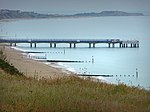
|
Boscombe Pier | 1888 | Bournemouth | 40 m (131 feet), originally 200 m (656 feet) long | The old Boscombe Pier was built in 1888 as a visitor attraction and had two docks for steamers. In 1926 a building was built on the land side of the pier. During World War II, British troops destroyed the pier to avoid invasion by enemy attackers. After restoration work, it was reopened in 1962. In 1989 and 2005, the Boscombe Pier was closed again and only reopened in 2008 after extensive renovations. |
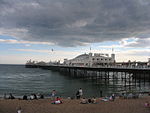
|
Brighton Palace Pier | 1899 | Brighton | 525 m (1722 feet) | Brighton Pier was built in the 1890s as a "replacement" for the Royal Suspension Chain Pier, which was destroyed in a storm in 1896. In the 1910s, the pier was a popular destination. The pier was closed during the First and Second World Wars and reopened after 1945. The famous theater, which was damaged in 1973, was torn down in 1986 after a buy-out. After 1986, numerous rides opened, including a roller coaster. The pier is now owned by the Electric Bar Group and is a listed building. With four million visitors annually, it is one of the most popular attractions in Brighton. |

|
Brighton West Pier | 1866 | Brighton | 340 m (1115 feet) | The West Pier in Brighton was designed by Eugenius Birch and opened in 1866. After the Chain Pier, it was the second pier that had been built in Brighton. In 1893 the pier was expanded; The concert hall was inaugurated in 1916. After the Second World War, the pier increasingly lost its popularity. In 1965 a local company bought the building, but soon filed for bankruptcy. About ten years later the pier was closed
and fell into disrepair. In 2003 a fire destroyed a large part of the bridge; In 2010, more parts were demolished to build the i360 observation tower . |

|
Royal Suspension Chain Pier | 1823 | Brighton | 309 m (1040 feet) | The pier, popularly known as the "Chain Pier", was designed by Samuel Brown and built between 1822 and 1823. In the first few years after its construction, the pier served as a landing stage for package boats. From the 1830s the pier was a popular destination. The pier was one of the first piers to have a camera obscura . In the mid-1860s, the building gradually fell into disrepair and was eventually to be demolished in the early 1890s. In December 1896 a severe storm destroyed a large part of the bridge structure. |

|
Burnham-on-Sea Pier | 1914 | Burnham-on-Sea | 37 m (117 feet) | The pier, which was built from 1911 to 1914, is the shortest pier in the United Kingdom at around 37 m. In contrast to other piers that were built during this period, the pier was built on concrete piles. |

|
Clacton Pier | 1871 | Clacton-on-Sea | 360 m (1180 feet) | The original pier was built on wooden piles and was 150 meters long. After the opening, the pier served mainly as a landing stage for passenger and cargo ships. In 1893 Clacton-on-Sea developed into a popular excursion destination, so the pier had to be extended by 210 m. |

|
Clevedon Pier | 1869 | Clevedon | 310 m (1020 feet) | In the 1870s Sir John Betjeman called the steel structure "the most beautiful pier in England". It has been a listed building since 2001. |
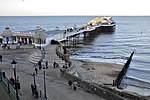
|
Cromer Pier | 1901 | Cromer | 151 m (495 feet) | The listed pier is located in Norfolk 40 km north of the city of Norwich . The pier is the main station of the Cromer Lifeboat Station . As one of the few piers, the Cromer Pier houses a theater that is still in operation today. |
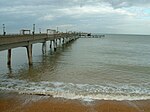
|
Deal Pier | 1957 | deal | 311 m (1026 feet) | Deal's first pier was built in 1838. After it was badly damaged in a storm in 1864, an iron bridge was built at the same location. A Dutch ship damaged the second bridge during World War II. The current concrete pier dates from 1957. |
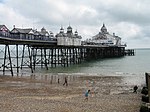
|
Eastbourne Pier | 1870 | Eastbourne | 300 m (1000 feet) | The pier was designed by British engineer Eugenius Birch and constructed from 1866 to 1872. It was opened in 1870 by Lord Edward Cavendish. The building has a theater, a bar, several offices and a camera obscura . |

|
Prince of Wales Pier | 1905 | Falmouth | 155 m (510 feet) | The reinforced concrete pier was commissioned by EH Page and designed by WH Tressider. It is named after George V named. |

|
Felixstowe Pier | 1905 | Felixstowe | 140 m (450 feet) | Felixstowe Pier in the eastern English coastal town of Felixstowe opened in 1905. Up to the Second World War, it was one of the longest piers in the country with a total length of 800 m. During the war, British troops split the bridge in two. After 1945 the dilapidated part of the footbridge was demolished without replacement. |

|
Britannia Pier | 1858, 1901 | Great Yarmouth | 1858: 210 m (700 feet), 1901: 246 m (810 feet) | The pier is a listed building (Grade II.) And houses a theater of the same name. |

|
Wellington Pier | 1853 | Great Yarmouth | 210 m (700 feet) | The pier is a purely wooden structure and was opened on October 31, 1853. In 2008 the theater was converted into a bowling alley with ten lanes and several pubs and bars. |

|
Hastings Pier | 1872 | Hastings | 280 m (910 feet) | Hastings Pier was a popular meeting place in the 1930s and a well-known place for musicians from the 1960s. In 1990 the structure suffered severe damage from a storm and had to be closed. Around twenty years later, a fire destroyed a large part of the pier. The current pier was built in 2016. |

|
Herne Bay Pier | 1899 | Herne Bay | 1154 m (3787 feet) (through 1978) | The Herne Bay Pier was the third bridge structure and the landing stage for passenger steamers in Herne Bay. Originally 1187 m long, it was badly damaged in a storm in 1978. In 1980 the damaged area was torn down, reducing the length. The narrow-gauge railway tracks, which replaced a tram line in 1950, were discontinued. |
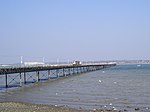
|
Hythe Pier | 1870 | Hythe | 640 m (2099 feet) | |
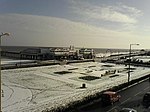
|
Claremont Pier | 1903 | Lowestoft | 218 m (715 feet) | |

|
St. Anne's Pier | 1885 | Lytham St Annes | 180 m (600 feet) | |

|
Paignton Pier | 1879 | Paignton | 240 m (780 feet) | |

|
Clarence Pier | 1861 | Portsmouth | ||

|
South Parade Pier | 1879 | Portsmouth | ||

|
Ryde Pier | 1814 | Ryde | 681 m (745 feet) | |

|
Saltburn Pier | 1869 | Saltburn-by-the-Sea , Redcar and Cleveland | 208 m (681 feet) | |

|
Sandown Pier | 1879, 1895 | Sandown | 1879: 110 m (360 feet), 1895: 297 m (875 feet) | |
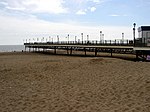
|
Skegness Pier | 1881 | Skegness | 1881–1978: 562 m (1844 feet), since 1978: 118 m (387 feet) | |

|
Southend Pier | 1830, 1889 | Southend-on-Sea | 2158 m (7080 feet) | |
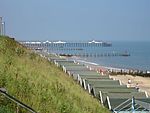
|
Southwold Pier | 1900 | Southwold | 190 m (620 feet) | |

|
Swanage Pier | 1860, 1895 | Swanage | ||

|
Grand Pier (Teignmouth) | 1867 | Teignmouth | 212 m (696 feet) | |

|
Princes Pier | 1915 | Torbay | 580 m (feet) | |
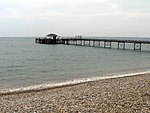
|
Deadland Pier | 1880 | Deadland | 137 m (450 feet) | |

|
Walton Pier | 1830, 1880 | Walton-on-the-Naze | 1830: 91 m (300 feet), later 240 m (800 feet), 1895: 790 m (2600 feet) | |

|
Grand Pier | 1904 | Weston-super-Mare | 366 m (1201 feet) | |

|
Birnbeck Pier | 1867 | Weston-super-Mare | 351 m (1150 feet) | |

|
Worthing Pier | 1862 | Worthing | 290 m (960 feet) |
Scotland
| image | Surname | completion | location | overall length | Remarks |
|---|---|---|---|---|---|

|
Kilcreggan Pier | Kilcreggan |
Wales
| image | Surname | completion | location | overall length | Remarks |
|---|---|---|---|---|---|

|
Royal Pier (Aberystwyth) | 1865 | Aberystwyth | 242 m (794 feet) | |

|
Garth Pier | 1896 | Bangor | 470 m (1550 feet) | |

|
Beaumaris Pier | 1846 | Beaumaris | 170 m (570 feet) | |

|
Landerneau Pier | Caernarfon | |||

|
Victoria Pier | 1900 | Colwyn Bay | 227 m (750 feet) | |

|
Llandudno Pier | 1877 | Llandudno | 700 m (2295 feet) | |

|
Mumbles Pier | 1898 | Mumbles | 255 m (835 feet) | |

|
Penarth Pier | 1895 | Penarth | 1898: 200 m (658 feet), 1998: 198 m (650 feet) | |
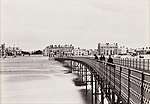
|
Rhyl Pier | Rhyl | |||

|
Trefor Pier | Trefor |
Isle of Man
The Isle of Man belongs directly to the Crown.
| image | Surname | completion | location | overall length | Remarks |
|---|---|---|---|---|---|

|
Queen's Pier | 1886 | Ramsey | 658 m (2160 feet) |
See also
Web links
Commons : Piers in the United Kingdom - Collection of pictures, videos and audio files